
slate point
Colour: Black and shades of blue, green, brown and buff.
Texture: fine-grained.
Structure: By definition, slates are characterized by a single, perfect cleavage (slaty cleavage), enabling it to be split into parallel-sided slabs. On the cleavage surfaces sedimentary structures such as bedding and graded bedding can often be seen. Fossils may be preserved but are invariably distorted. Folds are often apparent in the field.
Mineralogy: Too fine-grained to distinguish with the naked eye. Pyrite porphyroblasts often occur, usually as cubes.
Field relations: Slates are produced by low-grade regional metamorphism of pelithic sediments (shales, mudstones) or fine-grained tuffs. They may be associated with other metamorphic sedimentary or volcanic rocks Hamilton et al. (1976: 150)

slate point
Colour: White, grey, reddish.
Texture: Medium-grained; usually of a granoblastic texture.
Structure: Usually massive but primary sedimentary features may be
preserved, such as bedding, graded bedding or current bedding.
Mineralogy: Essentially composed of tightly interlocking grains of
quartz. A little feldspar or mica may also be evident. White varieties are
distinguished from marble by their greater hardness.
Field relations: Quartzites are metamorphosed quartz sandstones and
are found in association with other metamorphosed sedimentary rocks such as
phyllite, schist and marble (Hamilton et al.1976: 188).
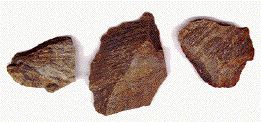
quartzite flakes
Quartz is composed mainly by SiO2, and its structure is crystalline. Quartz occurs in many varieties. Rock crystal is colourless quartz and sub-varieties include ghost quartz in which growth stages are marked by inclusions, and rutilated quartz (sagenite), which contains hair-like rods of rutile. Amethyst is purple; milk quartz is white; rose quartz is rose-red or pink, and is usually found massive rather than as crystals. Citrine is yellow and transparent and resembles topaz. Smoky quartz (sometimes called cairngorm) is smoky brown to nearly black. Some quartzes contain impurities that not only impart a colour but render them opaque. Ferruginous quartz is an example of this and is commonly brick-red or yellow.
Distinguishing features: Crystal form, conchoidal fracture, vitreous lustre,
hardness.
Occurrence: Quartz is one of the most widely distributed minerals (Hamilton
et al. 1976: 128 ).
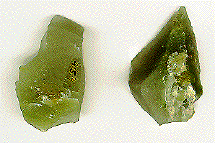
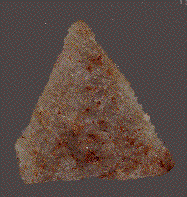
Rock crystal is quartz in crystalline form and is translucent. It has conchoidal fracture and therefore ideal for making tools.
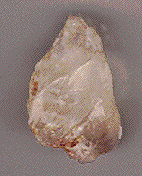
Colour: Blue-grey, grey, to nearly black when fresh, but weathers to a
whiteish, powdery crust (patina).
Texture: Very fine-grained and smooth; conchoidal fracture. Rough on
weathered surface.
Structure: Flint and chert form rounded nodules of widely differing forms,
but chert also forms massive beds. Flint nodules are often hollow and may contain a
fossil, such as a sponge or echinoid.
Mineralogy : Composed of silica, mainly the variety chalcedony. Some authors
distinguish flint and chert compositionally but the differences, if any, are slight.
Field relations: Flint and chert nodules occur typically in limestone and
chalk. They are usually patchily distributed but often concentrated along one bedding plane. Their origins are not fully understood; but some appear to be secondary replacements of the host rock, whilst others may represent primary deposition on the sea bed of colloidal silica
Hamilton et al. 1976: 204).
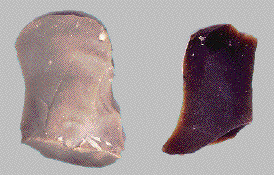
©
Internet Archaeology
Last updated: Thu Mar 20 1997